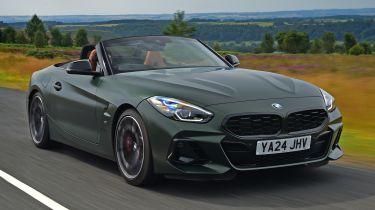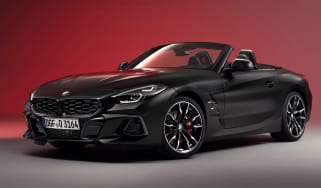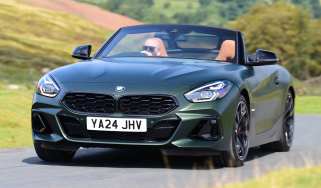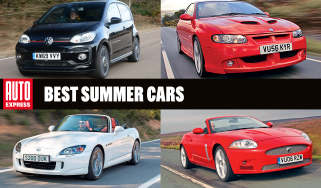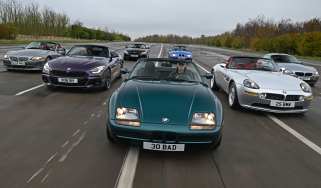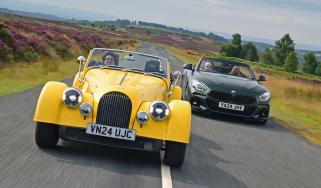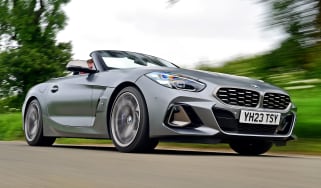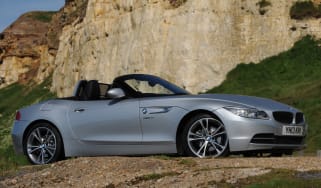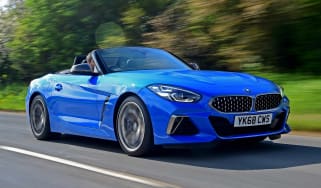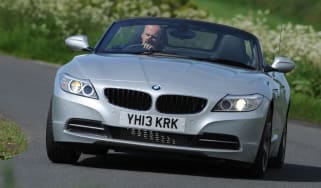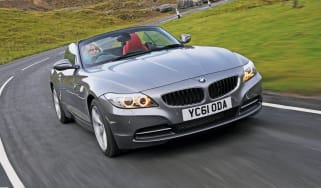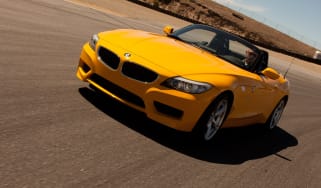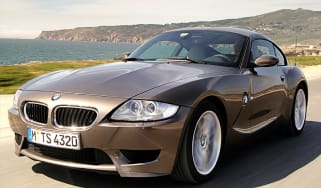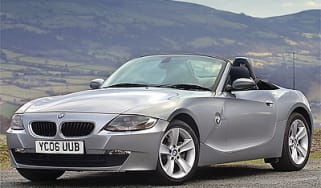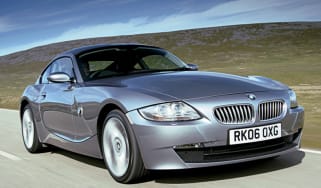BMW Z4 review
BMW’s Z4 front-engined, rear-drive sports car is an old-school delight, although keen drivers will favour a Porsche 718 Boxster

Verdict
The BMW Z4 remains one of the more sensible and balanced two-seater roadsters on the market. It’s grown into a very complete offering that really could be used every day, yet still has verve to excite its driver. BMW’s offering isn’t the sharpest or most thrilling way that sports car buyers could spend their cash but its style and all-round competence should guarantee a steady stream of buyers.
The BMW Z4 has been a consistent figure within the German marque’s line up for decades, but as one of the more vulnerable models on account of its niche appeal, it’s one that won’t be around for too much longer. Before BMW pulls the plug, though, this third generation Z4 has undergone a set of subtle yet important changes as it reaches its twilight years.
These changes include a consolidation of the engine range, and the introduction of a new Handschalter model that BMW hopes will drum up some interest from enthusiasts.
As with most modern convertibles, the latest Z4 has ditched the previous generation’s folding hardtop roof in favour of a simpler fabric unit. Even so, the Z4’s cabin is still very well insulated against unwanted noise, and the roof’s compact mechanism yields big packaging benefits.
Used - available now
Despite its short and wide footprint, the Z4 also has lots in common with BMW’s mainstream model range. This has both advantages and disadvantages, like the slick and highly engineered feeling on one side and the relatively high kerb weight on the other.
There are three Z4 versions available: a base four-cylinder Z4 sDrive20i, a six-cylinder M40i and the new M40i ‘Handschalter Package’. The entry model is the sole four-cylinder option and produces a fairly meek 194bhp. The Z4 M40i bumps this right up to 335bhp thanks to a turbocharged 3.0-litre six-cylinder engine, that’s good for a 0-62mph time of just over 4.5 seconds.
The Handschalter shares this same engine, but swaps out the standard eight-speed auto for a six-speed manual, and comes with a range of additional chassis tweaks.
Unfortunately, no Z4 feels as light on its feet or connected as rivals like the soon-to-be-discontinued Porsche 718 Boxster or an Alpine A110, but then beats both in terms of refinement and everyday usability. Build quality and overall specification are also hard to fault, and as sports cars go, it’s relatively practical too.
All Z4 variants are well equipped, as befits their prestigious image. Base M Sport models get 18-inch alloys, an impressive Live Cockpit Professional infotainment system with smartphone connectivity, heated seats, two-zone climate control, cruise control and LED headlights, shadowline exterior trim and M Sport bodystyling, plus M Sport suspension settings and an M Sport-branded steering wheel.
The M40i adds even more kit, including 19-inch alloys, adaptive suspension and an M Sport differential, as well as bodystyling and interior upgrades including electric seat adjustment. The Handschalter package ups the rear wheel size to 20-inches, plus adds-in a range of other small chassis tweaks including revised tuning for the dampers and anti-roll bars, recalibrated steering and distinctive Frozen Deep Green paint with Cognac leather.
Compared to when the third generation Z4 made its debut in 2019, there are very few direct rivals that current Z4 has to compete against. Only the Alpine A110, in reality, is still in full production for the foreseeable future. Porsche’s 718 Boxster S and Cayman S are no longer able to be ordered aside from the hardcore RS models, and they’ll be leaving a two-seater-sized gap in Porsche’s range until the all-electric replacement is ready in 2025.
Looking further afield, there’s Audi’s recently culled the TT Roadster, and Merc’s SLC (formerly SLK) is long-dead. The closely related Toyota Supra is expected to be back on sale soon, potentially with a more potent GRMN variant topping the range. But it, like the Z4, will call it quits some time in 2025. Both cars are currently built on the same line in Austria.
Engines, performance and drive
Despite the BMW Z4’s aggressive design and sporty proportions, it is not an all-out sports car like most of its direct rivals, instead it takes a more laid back approach to open-top motoring. The whole driving experience, regardless of the model, is just a little too uncommunicative to really engage and excite you in the same way as a Porsche or Alpine.
Lots of this has to do with a lack of feel, something missing in various elements of the driving experience. The steering, despite feeling a little more keyed-in than many BMW models, is still quite remote and doesn’t instil a huge amount of confidence.
A combination of a short wheelbase and wide track can also make the car feel a little snappy, while the very strong torque of the M40i, paired with the eight-speed auto, can make for a somewhat hair-raising experience when pushing on.
The Handschalter does go some way to alleviating these driveability issues due largely to a more consistent and connected feeling to both its engine and the rear wheels. There’s just that bit more clarity to how the power is being delivered to the massive rear tyres, plus the differential feels a touch more consistent.
Opt for the 2.0-litre four-cylinder sDrive20i and you'll enjoy a car that's a little lighter, and therefore a touch more agile. This is a worthy trade-off for its relative lack of straight-line punch in the more powerful M40i, but also comes with a big deficit in character and energy.
Overall, though, while it doesn’t rate well as a pure sports car, it’s still an impressive roadster. The chassis has a lovely balance to it – that’s down to BMW’s perfect 50:50 weight distribution – and there’s very little chassis wobble to worry about.
With the roof down, interior refinement is also excellent. The Z4’s standard wind deflector does a great job of managing the airflow right up to motorway speeds, and roof-up the fabric canopy still makes for a hushed and comfortable cabin – although the Handschalter’s wider rear tyres can drum up a bit of noise.
Engines, 0-60 acceleration and top speed
The headline powertrain for the Z4 remains its six-cylinder, which in this case is the well-proven ‘B58’ unit that’s found in everything from the aforementioned Toyota Supra to the Morgan Plus Six and even the Ineos Grenadier. In the Z4, it’s rated at a relatively light 335bhp with 500Nm of torque, but both of those figures are spread right across the rev-band, and that peak torque is almost available at tickover, or 1,600rpm more specifically.
The eight-speed automatic is quick-witted and shifts cleanly, but the short ratios can sometimes make the car feel a little breathless. Instead, if you manually select a higher gear and let the car lean into its torque, the Z4 feels more comfortable and less hectic. The six-speed manual, by contrast, feels a little archaic in its shift quality, but also draws a closer connection to the engine and adds critical feel.
Top-spec M40i models with the automatic will hit 0-62mph in just 4.5 seconds, with the Handschalter taking an extra 0.1 of a second; both accompanied by a suitably rorty howl. The four-cylinder option isn’t quite as thrilling, but performance is brisk even for the sDrive20i, which manages 0-62mph in 6.6 seconds. It’s not the most charismatic engine, though, and feels more comfortable surfing it’s mid-range rather than zipping up to the redline.
MPG, CO2 and running costs
Even the sportiest BMW Z4 M40i can post reasonable fuel consumption figures when driven with a modicum of restraint. The official figures suggest 33.6mpg is on the cards in mixed driving, but give in to the temptation of the M car’s easily accessible performance and that figure will quickly dip. The fuel tank isn’t that big at 52 litres, so you could end up making frequent fuel station stops. The Handschalter’s shorter final drive drops economy back to 32.5mpg.
The official WLTP fuel figures for the four-cylinder models are even more impressive with both the sDrive20i edging towards 40mpg under test conditions. CO2 emissions of 192g/km for the M40i means company car drivers will face top-bracket Benefit-in-Kind tax bills, although the four-cylinder Z4s still emit between 161g/km and 171g/km of CO2.
Insurance groups
The BMW Z4 insurance ratings sit between group 30 and 37, which is competitive compared to the Porsche 718 Boxster which ranges from group 46-49.
Depreciation
Premium sports cars tend to be in demand on the used car market, and the BMW Z4 doesn’t buck the trend. That means it’s a relatively safe place to put your money, with residual values of around 49 per cent for the 2.0-litre models and a slightly lower return for the M40i at around 46 per cent. Optional extras such as the M Sport Plus package will add desirability at resale time.
To get an accurate valuation on a specific model check out our free car valuation tool...
Interior, design and technology
The BMW Z4 is instantly recognisable as a Z car, with design lineage that’s traceable all the way back to the early Z3s – even if that’s just down to the long bonnet and short boot format. This latest model features new surface treatments that diverged from most other BMW models, keeping it looking fresh thanks to LED headlights, a wide grille, aero-focused intakes and heavily contoured flanks.
The car is built on BMW’s Cluster Architecture Platform, and is some 50kg lighter than its predecessor. Interestingly, the same underbody structure, suspension components and M40i engine also feature under the skin of the Toyota Supra coupe – it was developed in conjunction with the BMW through a joint venture.
Inside, the BMW Z4 design isn’t quite as exciting as the exterior, largely because BMW has chosen to install an interior that treads a much closer line to more mundane models like the 3 Series saloon. In fact, while most modern BMWs now feature a large curved dual-display, the Z4 retains the last cowled dash to be found in the range.
While the dash set-up works brilliantly in the saloon – and is hard to fault from a practical perspective in the Z4 – it lacks the sporty feel and flair we’d expect sports car buyers to want. The cockpit just doesn’t feel distinctive or special enough, compared to the cabins of rivals like the Porsche 718 Boxster, Alpine A110 or even the old Audi TT.
Things get a little more impressive when you start to look at the array of technology that’s available on the Z4. Available active assistance systems include lane-keeping, emergency braking and cruise control, as well as parking assistance.
Options include the Comfort Package with keyless entry, the M Sport Plus package with a range of sporty trim upgrades, a Visibility Package with automatic headlamp adjustment and a Technology Package with Head-Up Display and an audio system upgrade.
Sat-nav, stereo and infotainment
The BMW Live Cockpit Professional system is fitted as standard to the BMW Z4 and comes with a big 10.25-inch display in the centre of the dash, a fully digital instrument pack and BMW connected apps. Operated via the iDrive scroll wheel on the centre console it's an easy system to use, with crisp graphics and lots of functionality.
Adding the Connected Package brings Apple CarPlay (but not Android Auto), BMW Concierge Services and a Remote function that lets you find your car and unlock it via your smartphone.
Practicality, comfort and boot space
There’s only the one bodystyle available with the fabric soft-top, and no coupe option for BMW Z4 owners. This may deter some customers who liked the previous generation for the security and refinement of its retracting hard-top, but the upside is the latest roof doesn’t eat up all the Z4’s boot space when it’s retracted. If you really want a fixed roof, take a look at one of the Z4's many rivals.
The latest Z4's roof retracts and deploys electrically in around 10 seconds at speeds of up to 31mph, so you don’t have to pull over when the weather changes. The cabin is practical too, with usable door bins, glovebox and cubbies, although if you want to combine open-top motoring with trips to the DIY store, the larger four-seat 2 Series will doubtless make more sense.
Visibility from the Z4’s driving seat isn’t bad, but that long swooping nose could be awkward in tight parking situations, because you can’t see where it stops. However, parking sensors are standard, while the Parking Assistant self-parking system will be a boon to less confident drivers.
The small 52-litre fuel tank could be a nuisance, as it means trips to the filling station may be frequent.
Dimensions and size
The BMW Z4 measures up at 4,324mm long, 1,864mm wide and 1,304mm tall. That means it takes up a little more space on your drive than the 4,177mm x 1,832mm Audi TT and the 4,133mm x 1,810mm Mercedes SLC.
Leg room, head room & passenger space
The BMW Z4 has a decent amount of leg and headroom for its occupants, and feels less constrained than a Porsche 718 Boxster or Alpine A110. It has a greater range of seat adjustment than its predecessor too, so taller drivers have a better chance of finding a comfortable seating position.
Boot space
Z4 enthusiasts with touring aspirations will be delighted by the disappearance of the folding hard top which destroyed the luggage capacity of the previous model. The latest one is pretty good in this regard, at least for small-ish two-seater. You get 281 litres of boot space, and there’s an optional ski-hatch for longer items. The 718 Boxster has a similar amount of total luggage volume, but it’s considerably less useful as it’s split between the front and rear boots.
Reliability and safety
Euro NCAP crash tested the BMW Z4 in 2019 and awarded it a full five stars. The two-seater convertible achieved an excellent 97 per cent score for adult occupant protection, with child passenger safety rated at 87 per cent.
What we can say is there’s a lot of technology available should the worst happen. Apart from the obvious airbags, anti-lock brakes, chassis stability and tyre-pressure monitoring, the standard kit list includes autonomous emergency braking.
Unfortunately, if you want all the safety benefits the Z4 can provide you need to ‘spec up’ from the options list. Adaptive cruise control, lane-keeping assistance and parking assistance, as well as adaptive anti-dazzle headlamps, are all on the options list.
BMW came 21st out of 32 brands included in our 2023 Driver Power customer satisfaction survey, improving on previous years, but still short of rival premium brands like Porsche, Polestar or Lexus.
There’s nothing wrong with the perceived build quality of the Z4 mind you. It looks extremely well screwed together, and the materials used have a high-quality feel too.
Warranty
BMW’s three-year warranty includes unlimited mileage, which is exactly the same as the cover offered by both Mercedes and Porsche. Audi’s three-year cover is limited to 60,000 miles. You can extend the BMW warranty at extra cost beyond three years, but at that point a 100,000-mile cap comes into play.
Servicing
Like all BMW’s your Z4’s electronics will tell you when it needs a service, based on your driving style and constantly monitored oil quality. Few drivers are likely to escape an annual service, but the costs should compare favourably to those charged by Porsche. Routine maintenance will also be more expensive on cars driven hard, as tyres, brakes and other consumables wear out quicker – and are typically more expensive anyway due to their high-performance spec.

